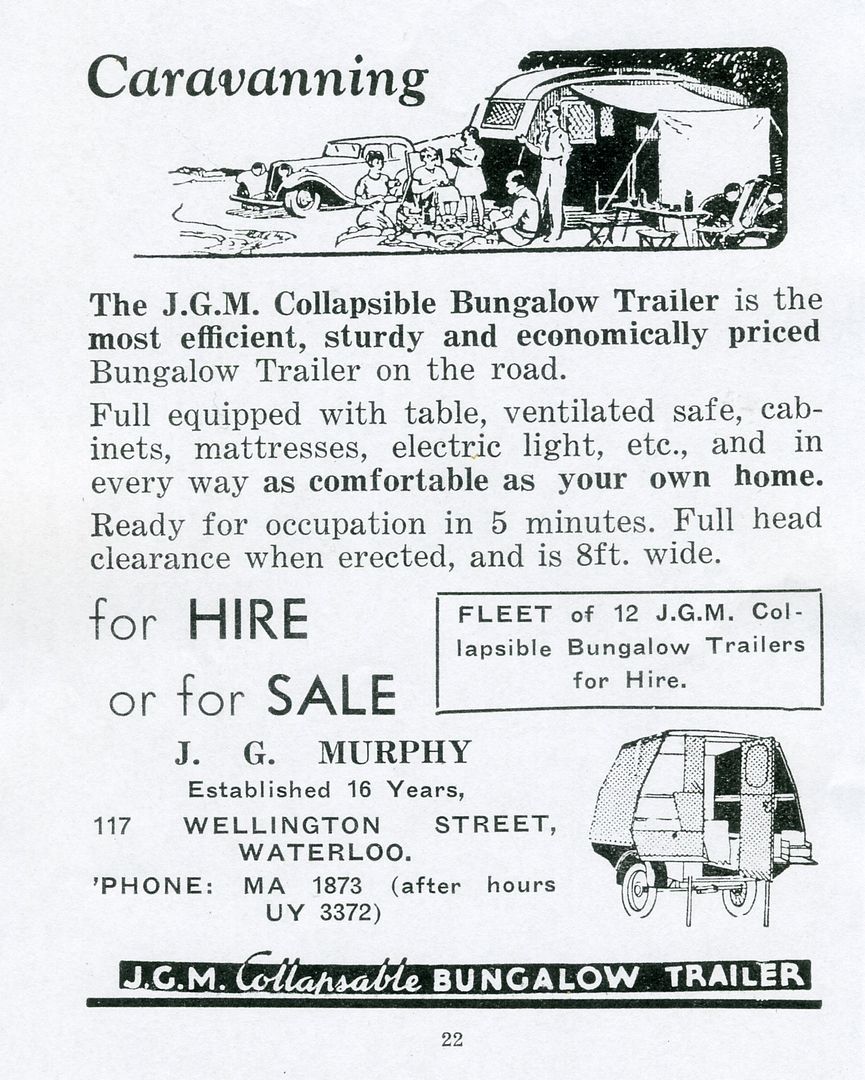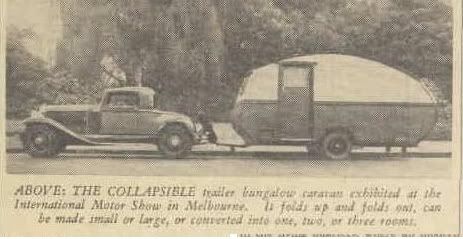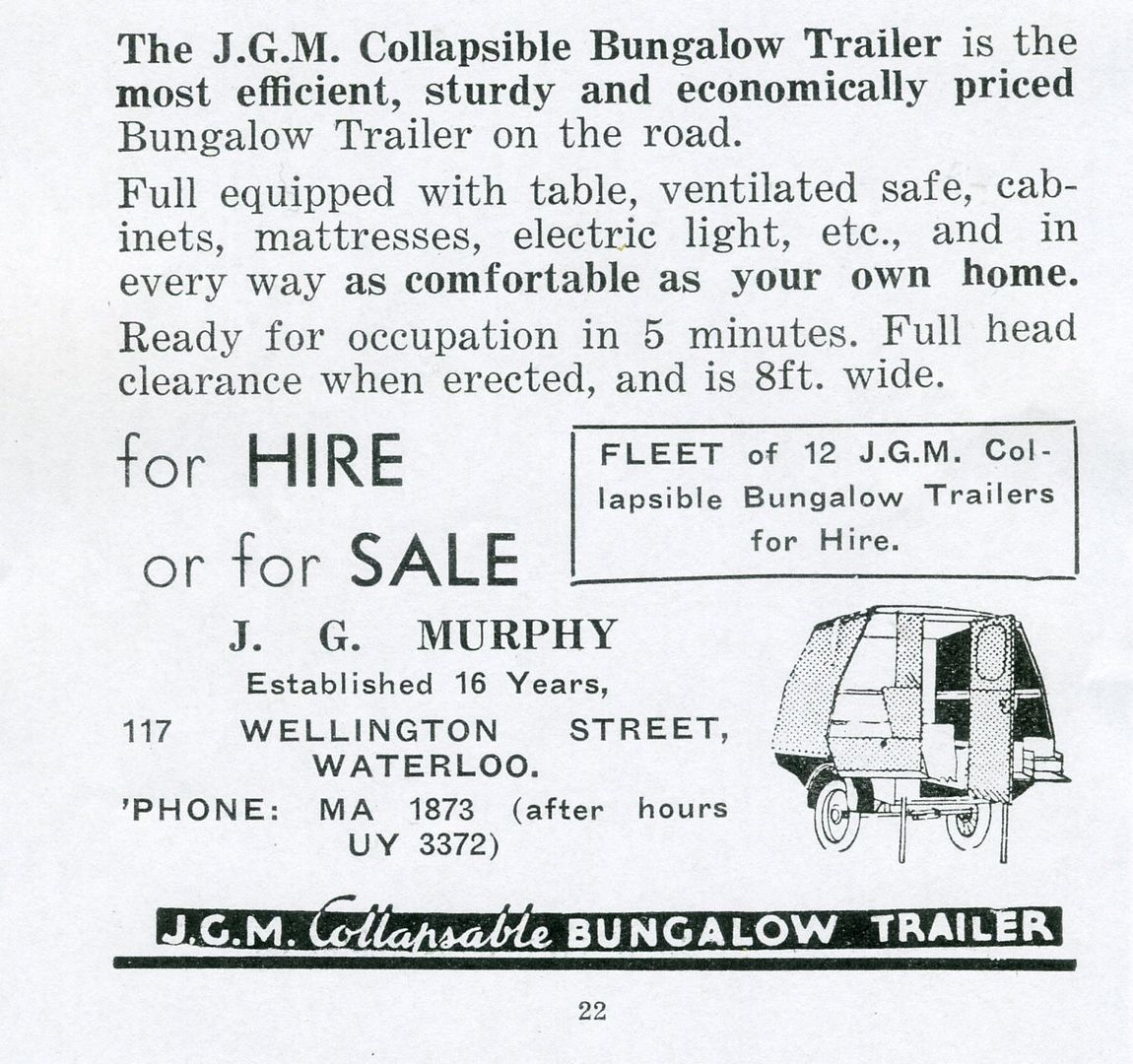|
|
Post by Don Ricardo on Mar 8, 2012 23:11:27 GMT 10
J.G.M. BUNGALOW TRAILERSManufactured by J G Murphy 117 Wellington Street, Waterloo, NSW
On 6 May 2011 53s2mm posted the following information about J.G.M Bungalow Trailers and Ledsam's Caravan Rentals:found this paper cutting in an old map book I just purchased. from the singer story I would say the year is 1939 _1.jpg) Further information about Ledsam's Caravan Rentals and Sunchaser caravans can be found by clicking here. Further information about Ledsam's Caravan Rentals and Sunchaser caravans can be found by clicking here.Note that the advertisement for Ledsam's Caravan Rentals refers to their caravans as 1938 models. One would think that they would only mention the year if they were wanting to indicate that the vans are new and/or up to date. This seems to confirm that the advertisements are from 1938, or from 1939 as 53s2mm surmised. Don Ricardo
|
|
|
|
Post by griffin on Mar 9, 2012 15:32:55 GMT 10
Don R Just to clarify the issue a little, J.G.M. Bungalow Trailers is a separate company, J.G. Murphy, and attached is an advertisement from the 1939-40 N.R.M.A. Camping and Caravan Guide, showing a collapsible caravan style, similar to a Brindle, offered for sale or hire. You might note that the banner across the bottom spells collapsible incorrectly too. J.G.M. displayed at the N.R.M.A. Caravan Show in Sydney but there was no description of what was displayed. I've been meaning to post this advertisement and the one from 52s2mm for a while. 52s2mm's advert also appeared occasionally in the 'Open Road' and shows a 'rigid roof' type van, does it indicate J.G.M. moved on to bigger and better as did Brindle? This J.G.M. advertisement indicates the company had been established for 16 years in 1938, but I've not been able to find any earlier reference to it. Unfortunately as this post shows, should we post by the manufacturer's name or by the brand name of the van? I chose to post Sunchaser rather than Ledsam as it appears prominent as the brand, whereas J.G.M. seems to predominate rather than Bungalow. I think I'm confused now. I'm sure as a highly paid Moderator you can sort this out for DHL to the satisfaction of all. George  |
|
|
|
Post by cobber on Mar 11, 2012 5:53:51 GMT 10
G'day George , YOU'RE CONFUSED !   The first advertisement you posted indicated the “collapsible Bungalow caravan” looked like a full size caravan. The next post (reply #1) shows a lantern roof van and another which would more likely be the “Collapsible Bungalow” style of van................. then I came across this item in the “Australian Women's Weekly” July 1935 as found in "Trove" . This indicates the “Collapsible Bungalow” caravan could indeed be made into a full size caravan.  If you click on the "Trove link" you can read a little bit more about the collapsible van and see a photo of an intriguing fifth wheeler built in 1935  .....in Australia  . Cobber.
EDITORIAL COMMENT - February 2023: Now that we know a little more about the JGM caravans and camper trailers (see below), it seems almost certain that the photo of the caravan in this post is not related to any of the JGM vehicles. It may be another (not infrequent) example of 'editorial confusion' where an editor has mixed up text and photographs, or just inserted a random photo of a caravan for illustrative purposes. Certainly the van in the photo does not appear to be of the folding type, and quite unlike any images we have of JGM Collapsible Bungalows. Don Ricardo |
|
|
|
Post by griffin on Mar 12, 2012 12:22:33 GMT 10
Hi Cobber I guess the lantern roof image didn't help but it's not actually part of the advertisement, only the header for the Caravanning section, which by the way has little else in it, only the JGM advert. I tried to edit the post to replace the image but don't seem to be able to so I'll re-post it here without the header. It certainly shows what we would all imagine of a collapsible style van of the 30s. The small advertisement for JGM showing the rigid roof style van appeared in 'The Open Road' in March 1939 and maybe both style vans were made. JGM don't seem to have reappeared after the War. I've read the Trove post before but it seems to me that the caption doesn't fit that photo. The coupe pictured towing the van appears to be some American make, probably 15-16 feet (or more) in overall length and the van shown is considerably larger than the car. The text indicates the collapsible bungalow they refer to as being the size of an ordinary trailer, and I think the term 'collapsible bungalow' was used fairly loosely for that type of van. Hopefully one of JGM's relatives will surface with some photos and information to help clarify the products. George  |
|
|
|
Post by austin125 on Jul 10, 2012 21:27:47 GMT 10
Just wondering whether the 'Bungavan' mentioned in Winser Book 2 of 1948/49 being a 10'6" van was infact made by the Bungalow Trailer Co?  Winser book seems to have no other detail. Not mentioned in any other Winser publications before or after this edition. Regards austin125 |
|
|
|
Post by Don Ricardo on Nov 25, 2013 13:20:55 GMT 10
Just wondering whether the 'Bungavan' mentioned in Winser Book 2 of 1948/49 being a 10'6" van was infact made by the Bungalow Trailer Co?  Winser book seems to have no other detail. Not mentioned in any other Winser publications before or after this edition. Regards austin125 Hi Austin125, A belated answer to your query! No, I don't believe that the Bungavan was built by J.G.M. Bungalow Trailer company. The Bungavan was one of Winser's caravan plans for the DYI caravan brigade. Don Ricardo |
|
|
|
Post by Don Ricardo on Feb 6, 2023 11:21:10 GMT 10
Hi all, Forum member 53s2mm first posted an advert for JGM Bungalow Trailers back in May 2011, and there was some discussion about the trailers in the year that followed. The Collapsible Bungalow Trailer, which was the main focus of the discussion, was essentially a folding camper trailer with canvas sides. The first mention of J G Murphy, the manufacturer of the JGM camping vehicles, in the Sydney newspapers is in an advert published in the Sydney Morning Herald on Saturday, 30 May 1936 (page 22) when he was advertising second hand motorcycle sidecars and repairs:  (Source: www.newspapers.com ) However, by the end of 1937 J G Murphy was advertising his JGM camping vehicles. This advert appeared in the Sydney Morning Herald on Saturday, 27 May 1937 (page 24):  It is easy to read this advert and miss an important clue. JGM produced Caravan Bungalows, Collapsible Bungalows and Luggage Trailers. 'Caravan Bungalow' was JGM's term for a full-size caravan, as opposed to his folding 'Collapsible Bungalow' camping trailers. An advert printed in the Sydney Morning Herald on Saturday, 26 February 1938 (page 28) provides a detailed description of the Caravan Bungalow:  (Source: www.newspapers.com ) Note in particular that the Caravan Bungalows included 'lantern louver (sic) roof', 'two full size adjustable bedroom lounges' (ie four berths), 'full height wardrobe with mirror', 'water through pump', radio,'four electric lights' and 'plate glass windows with chrome frames'. All of these features can be seen in the photos below, and many of the features would have been quite luxurious touches in the 1930's. Towards the end, the advert states 'Practical Caravaneer for past 10 years' which may possibly mean that J G Murphy had been producing camping vehicles of some sort since the late 1920's. The following photos were taken by an Australian Consolidated Press photographer at the 'Murphy Motor Works' on 17 March 1938. Note the partially visible JGM Collapsible Bungalow behind the caravan in the first photo. Judging from the photos, the caravans were quite stylish and well set up. J G Murphy continued to advertise his Bungalow Trailers until the end of 1939, after which production presumably stopped because of the commencement of World War II. However, although apparently no longer producing caravans, the J G Murphy business did resume after the War producing motorccyle sidecars and chassis. Advertisements and references to J G Murphy continued in the press up until 1954. One reference was to a burglary and dynamiting of the safe at J G Murphy's premises in 1948, as reported in the Sydney Sun on Saturday, 14 August (page 3): _Sat_14Aug1948_p3_article229010753.png) (Source: National Library of Australia nla.gov.au/nla.news-article229010753 ) Thanks to Woody99 (Andrew Woodmansey) for the link to the Mitchell Library photos.
Don Ricardo
|
|